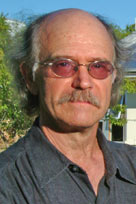Home
Previous Issue
Next Issue
College Home
College Calendar
Aggie Daily
- - - - - - - - - - - - - -
Media contact:
Phillip Rollfing
979.458.0442
email |
| |
| |
Innovation, new designs needed

Gulf Coast needs an extreme makeover,
says disaster recovery expert
| |
|
According to a Texas A&M University researcher who specializes
in disaster recovery and sustainable development, it's not enough
to think about merely rebuilding New Orleans: America's Gulf Coast
needs an extreme makeover to deal constructively with the millions
of tons of waste materials that flow down the Mississippi River
each day.
"What is needed is not just a clean-up," says Pliny Fisk, an
architecture professor at Texas A&M. "We need to establish
a new economic model for prosperity. Experts from such diverse
fields as architecture, industrial ecology, biochemistry, microbiology
and biomimicry are needed to address the metabolic flows of wastes
into the environment and derive ways of recovering and innovatively
reusing them or of finding benign replacements. We need both major
planning and economic initiatives that support nature's ability
to act and function efficiently. This approach often is referred
to as capitalizing on nature's economy."
Fisk's concern with new designs for the Gulf Coast began in the
1960s when he was a student of renowned landscape architect Ian
McHarg at the University of Pennsylvania. McHarg made him coordinator
of a project to design a floating "new town" which McHarg
subsequently named New Orleans East.
"My charge was to help design a new type of floating town,
one that would be responsive to hurricane conditions, that would
protect
human life and contribute to conservation of the wetlands on which
the city depends," says Fisk. "Our intent was to focus
on a new kind of business development, with some businesses mimicking
nature, thus putting such things as waste to good use. Other businesses
would protect nature instead of fostering continued mining of heavy
metals.
"One of our chief concerns was to manage the amounts and types
of waste flowing into these wetlands, while maintaining the connections
there between marine life and the food chain, connections which
form an essential basis for our food system."
Solutions developed by Fisk's team called for the development of
a series of local industries that would clean toxic wastes produced
in the area and produce such things as oil from waste organics
like the garbage sent down the river by the barge-full. Technologies
such as pyrolysis could be used to turn waste materials into useful
products ranging from energy to building components. They foresaw
that such a plan could benefit Gulf Coast industries, homeowners,
consumers and job seekers. They called their creation of an ecological
new town "Ponchatrain East."
"A number of benefits could accrue to the nation from this
industrial metabolism approach, such as reestablishing the second
most productive
fishing grounds (next to Alaska) in the U.S. or proving that the
capacity of marsh plants to accumulate bio-hazardous waste in the
delta might be as important as their protective effects during
flood surges," says Fisk. "The possibility also exists
to mine heavy metals from a carefully managed series of wetlands."
"We need to develop industrial-ecosystem models paralleled
by good economic input-output models," he continues. "We need
to understand that the one ingredient missing in U.S. planning
procedures is inclusion of byproducts and toxins, especially those
coming down the Mississippi River every day - this is data waiting
to be put to good use and that will define our ecological and economic
futures."
| |
 Pliny Fisk
Pliny Fisk
|
|
| |
|
|

